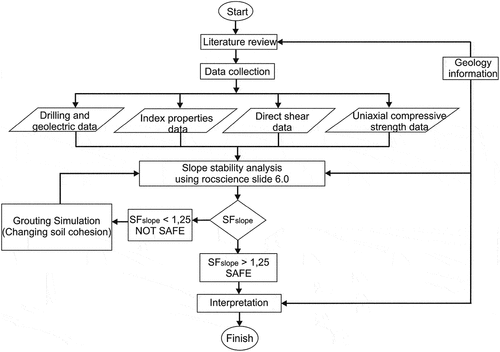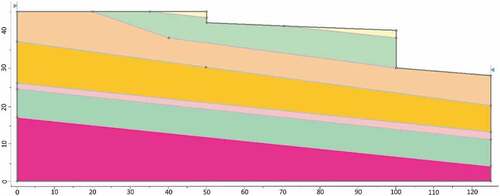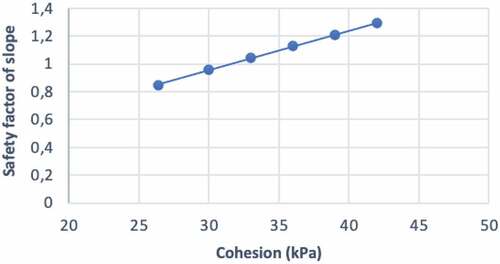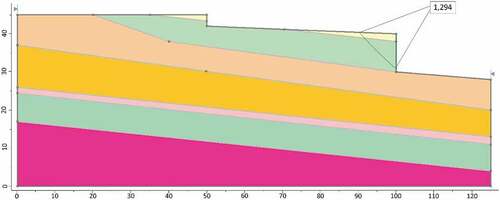 ?Mathematical formulae have been encoded as MathML and are displayed in this HTML version using MathJax in order to improve their display. Uncheck the box to turn MathJax off. This feature requires Javascript. Click on a formula to zoom.
?Mathematical formulae have been encoded as MathML and are displayed in this HTML version using MathJax in order to improve their display. Uncheck the box to turn MathJax off. This feature requires Javascript. Click on a formula to zoom.Abstract
Semarang is one of the industrial cities that continues to experience developments that eventually force peri-urban areas such as Gunungpati District to be converted into residential areas. Cepoko is one of the subdistricts in Gunungpati District that has developed into a subservice center along with the development of settlements in this district. The fact that Cepoko is in a sloping area and many landslides that have occurred make the risk of landslides become the reason for the importance of slope stability analysis. Grouting is a soil strengthening method to increase soil particle bonding so that it can be a solution for landslide prevention in sloping areas. The purpose of this study is analyzing the slope stability and simulating the grouting method. This study takes secondary data such as core drilling data, geoelectric data, and laboratory test data (index properties test, direct shear test, and uniaxial compressive test) obtained from Selimut Bumi Adhi Cipta Inc. The slope stability analysis is one of the methods to interpret field subsurface structure using index properties test, direct shear test, and uniaxial compressive test by software of rocscience slide 6.0. After interpreting field subsurface structure then grouting simulation applied into software to compare initial slope stability and after applying grouting. The results of the slope stability analysis showed that the initial slope had a safety factor of 0.847, indicating that the potential for landslides often occurred. The grouting simulation was carried out by changing the cohesion six times, strongly influencing the increase in the safety factor to 1.294, indicating a relatively stable slope.
PUBLIC INTEREST STATEMENT
Indonesia is an archipelago country with a beautiful natural landscape. Indonesia is located in three plates: Eurasia, Indo-Australia, and the Pacific, which result in an abundance of geothermal energy and frequent natural disasters. Indonesia has varied topographic; lowlands and highlands; moreover during the rainy seasons, the landslides occurred in several areas. In this paper, we presented the case study of Cepoko area, Semarang. This study describes the relationship between the resistivity of underground rocks with other physical parameters such as water content (w), specific gravity (Gs), porosity, void ratio, and degree of saturation. The fact that Cepoko is in a sloping area and many landslides have occurred make the risk of landslides become the reason for the importance of slope stability analysis. Mapping and modeling of disaster areas is an important thing, so that in the event of landslides it can minimize casualties.
1. Introduction
Semarang is one of the industrial cities that continues to experience developments that eventually force peri-urban areas such as Gunungpati District to be converted into residential areas. The development of settlements in Gunungpati has encouraged Cepoko to develop into a subservice center such as trade and service facilities, educational facilities, health facilities, religious facilities, and public service facilities (Nugraha & Sidiq, Citation2019). Furthermore, Cepoko is located in an area with a slope of 2–40%. Cepoko is dominated by the clay that can risk becoming a sliding field during the rainy season as interpreted from resistivity (Alina et al., Citation2020). Resistivity method can be used as one of the geoelectrical methods, which results of the lithology. The resistivity method is the measurement of the flow of electricity on the inside surface of the earth. According to the Regional Hazard Database of Semarang, landslides have occurred as many as 23 cases from 2019 to 2020. Unwise land conversion on steep sloping areas can trigger landslides. High rainfall intensity increases the water content in the soil and decreases the geotechnical properties (cohesion and angle of internal friction) that are decreasing slope stability (Jagodnik, Citation2019; Miščević & Vlastelica, Citation2014).
The steep slope has the potential to increase the driving force and trigger landslides, and it is necessary to analyze slope stability to avoid casualties due to landslides (Kaya, Citation2017; Kumar et al., Citation2017). Moreover, the water infiltration contributes to the instability of the slope because it significantly reduces the shear strength of soil (Hou et al., Citation2018). The slope stability will be determined based on the value of the safety factor from the analysis of slope stability (Fattahi, Citation2017). The safety factor that does not fulfill the value of a safe slope requires a soil improvement solution. In order to analyze the slope stability, the researchers applied and combined several methods to develop the effective soil reinforcement. Kassou et al. (Citation2020) found that the assessment of safety factor improved with the vertical drain technique. Fazelabdolabadi and Golestan (Citation2020) developed a Bayesian framework for quantification of micro-scale porous structure. Moreover, indirect technique and simulation have been developed to make easier the geotechnics research. Qiu et al. (Citation2018) revealed through simulation and observation that local topographic condition plays an important role in influencing landslides size. Besides, Wang and Xiong (Citation2020) proposed the numerical analysis to establish the shear strength of sliding model and found the angle of the anchor strongly influences the shear strength.
The application of grouting for slope stability has increased due to ease of construction, economic rationality, and better geotechnical properties (Bhuiyan et al., Citation2019; Njock et al., Citation2018). Grouting is often applied in many geotechnical fields such as digging and embankment stabilization, increasing soil strength for building foundations, slope stability, support tunnels, water retention, etc. (Evangelista et al., Citation2015; Hashim & Islam, Citation2008). Grouting method through the simulation proposed in this article strengthens soil particles. The fundamental principle is reducing the volume of the soil pore structure through the injection of cement into the soil so that its permeability will decrease (Nikbakhtan & Osanloo, Citation2009; Sun et al., Citation2019). Grouting has been suggested and applied for soil reinforcement and rock stabilizing, slope stability, liquefaction mitigation, construction of excavation support systems or protection of structure close to excavation sites, solidification and stabilization of contaminated soils, remedial grout injection of building, etc. (Kazemian & Huat, Citation2009). Gamil et al. (Citation2017) conclusively proved that grouting can be used as an effective way to improve the strength characteristics significantly. Grouting that was simulated by Najib et al. (Citation2018) reduces the permeability and increases soil strength, therefore, strengthening the safety factor.
We presented an introduction in the earlier paper to point the urgency of the landslides occurring in Indonesia especially the studied area of Cepoko. Geology information presents to help researchers to validate the data and the result, which can enable understanding the cause and the effect. We reviewed some principles of the collection, analysis, and management of secondary data to help doing research in Cepoko area. The necessity and innovation of this research is to improve the soil strength and increase the slope stability. Lastly, we underscored the summary of this study related to the soil reinforcement.
2. Geology information
The studied area lies in Cepoko Village, situated in Gunungpati District, Semarang City. Semarang is a capital city of Central Java Province, Indonesia, with population growth increases in the number of settlements making Cepoko one of the settlement options. The coordinates of the studied area are located at 7º4’26“–7 º4’30“ S longitudes and 110º21’30”–110º21’32” E latitudes. The slope gradient varies from 2% to 40%. According to the Map of Regional Geology of Magelang-Semarang, Central Java Province, Gunungpati District is composed of Damar Formation (Qtd), Kerek Formation (Tmk), Kaligetas Formation (Qpkg), and Kaligesik Volcano Rocks (Qpk), Jongkong Formation (Qpi), and Kalibeng Formation (Tmkl).
Cepoko is composed of the Kaligetas Formation. This formation consists of breccias and lava with lava inserts and fine to coarse tuff, the lower part of which is claystone-containing mollusks and tuff sandstone. Breccias and lahars are dark brown in color with components in the form of andesite, basalt, pumice with a tufa base mass. Tuff is whitish-yellow, fine-coarse, high porosity, and brittle. Claystone is green in color, low porosity, rather hard when dry, and easily crushed when wet. The location of the studied area is shown in .
Figure 1. Map of studied area information, BH-1 and BH-2 are core drilling points, GL-1 and GL-2 are geoelectric points (Alina et al., Citation2020)

3. Methodology
This study was carried out based on secondary data, which includes core drilling data, geoelectric data, and laboratory test data obtained from Selimut Bumi Adhi Cipta Inc. The core drilling and geoelectric data based on Alina et al. (Citation2020) that identify the subsurface lithology of Cepoko Village. The core drilling point includes points of BH-1 and BH-2 with a depth of 33 and 40 m, respectively. The geoelectric method was carried out using Schlumberger configuration with a length of 100 m, respectively, at two points includes points of GL-1 and GL-2. This study is the continuation of Alina et al. (Citation2020) that simulated the slope stability in Cepoko Village. Slope stability analysis was performed using software of rocscience slide 6.0.
Soil samples used in laboratory test data for this research were obtained from two core drilling points of BH-1 and BH-2, and five samples were taken with different depth from each point. Some of the laboratory test data needed for slope stability analysis is the data from the index properties test to obtain the physical properties such as the unit of weight, water content, specific gravity, porosity, void ratio, and degree of saturation. Direct shear test and uniaxial compressive strength test were used to obtain the geotechnical properties such as the cohesion (c) and the angle of internal friction ().
Shear strength is an important component in slope stability (Salih, Citation2012). Soil shear strength is derived from the cohesion (c) and the angle of internal friction () of the soil (Aladejare & Wang, Citation2018). The shear strength formula is characterized by the Mohr–Coulomb failure criteria as in Equationequation 1
(1)
(1) (Maffra et al., Citation2019).
where τ is the shear strength (kg/cm2), c is the cohesion value (kg/cm2), is the angle of internal friction (°), and σn is the normal stress (kg/cm2). The slope safety factor is closely related to the properties such as material behavior and slope geometry and the influence of external factors such as rainfall (Liu et al., Citation2014). The value of the safety factor is obtained from equation 2.
where SFslope is the safety factor of a slope, τ is the shear strength of the soil, and τd is the driving force of the soil. The slope safety factor (SFslope) is a value that describes the stability level of a slope. The classification of the value of the slope safety factor on slope stability is presented in .
Table 1. The relationship between SFslope and landslide intensity (Bowles, Citation1984)
Rocscience slide 6.0 software is capable of calculating the probability of slope stability based on the principle of the limit equilibrium method (Johari & Mousavi, Citation2019). The limit equilibrium method is a method of equilibrium between the forces that resist landslides and the forces that cause landslides. Rocscience slide 6.0 quickly calculates the safety factor for thousands of surfaces at various depths, orientations, then isolates the most critical surface or path with the least safety factor (You et al., Citation2016). The results of the slope stability analysis will obtain the smallest value of the slope safety factor. The value of the safety factor including unsafe slopes (SFslope < 1.25) was then performed grouting simulation by changing the cohesion value in the soil layer with the smallest SFslope. The simulation results have shown a safe slope (SFslope > 1.25) and then interpreted. The research flow chart is shown in .
4. Results and discussion
4.1. Analysis of geoelectric data
The subsurface layer in the studied area consists of a layer of clay, sandy clay, loamy sand, gravel sand, and andesite are presented in . Based on the results of geoelectric processing along with core drilling data, clay dominates the soil type in Cepoko, which has the potential to be a sliding field during the rainy season (Alina et al., Citation2020).
Table 2. Soil composition and soil resistivity of BH-1 and BH-2 (Alina et al., Citation2020)
4.2. Analysis of laboratory test data
Soil investigations are carried out to determine the physical properties of soil. The physical properties consist of unit of weight, water content (w), specific gravity (Gs), porosity, void ratio, and degree of saturation. The unit of weight is defined in the condition of wet, dry, and saturated is presented in . The water content (w), specific gravity (Gs), porosity, void ratio, and degree of saturation are shown in .
Figure 3. Soil index properties results: water content (a), specific gravity (b), porosity (c), void ratio (d), and degree of saturation (e)
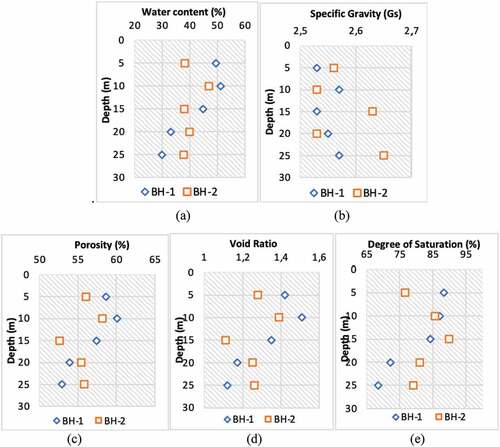
Table 3. The unit weight of soil BH-1 and BH-2 to depth
The results of soil physical properties are influenced by the type of soil. Based on core drilling data, it shows that the soil types in BH-1 and BH-2 are almost the same, at a depth of 0–10 m, they are the clay, sandy clay, brown to reddish-brown, soft to stiff, and there is pebble gravel. At a depth of 10–25 m, they are sandy loam, loamy sand, brown, soft to stiff, and there is gravel. At a depth of 15–25 m, they are loamy sand, sandy clay, gravel sand, brown to gray, hard to very stiff, and there are pebble gravel and cobble gravel.
Based on the results of soil physical properties that include the unit of weight, water content, specific gravity, porosity, void ratio, and degree of saturation, it shows the suitability of the soil physical parameter properties with the type of soil in the research location. The soil in the research location shows that the deeper the soil, the greater the hardness. At a depth of 0–10 m, the soft soil properties allow water to pass more easily than the 10–25 m depth, which is harder. It can be ascertained that a depth of 0–10 mhas a greater porosity, pore number, and degree of saturation than at a depth of 10–25 m. Soft soil properties will have less unit of weight and specific gravity than hard soil.
The geotechnical properties of cohesion and angle of internal friction obtained through the direct shear test and uniaxial compressive strength test are presented in .
Table 4. The cohesion and the angle of internal friction
Based on , the cohesion of BH-1 obtained ranged from 19.9 to 34.2, and BH-2 ranged from 5.6 to 33.7 kPa for BH-2, the non-zero cohesion value indicates that the soil layer contains cohesive soil types, namely clay or silt. The angle of internal friction (ϕ) of BH-1 ranged from 6.99 to 40.72 and BH-2 ranged from 19.91 to 34.64. The results show that the soil of BH-1 is a very loose and dense soil type. The soil density level of BH-2 is a very loose and loose soil type (Bowles, Citation1984). Very loose soil conditions have many voids that refer to the potential for volume changes due to loading.
4.3. Analysis of slope stability
Analysis of slope stability was carried out to obtain the safety factor of the slopes (SFslope) in the research location using rocscience slide 6.0. Based on the lithology and laboratory test data, the soil parameters used are presented in .
Table 5. Soil parameters before grouting
The slope dimensions analyzed are 125 m in length and 45 mof height. The initial design for analyzing slope stability in Cepoko Village, Gunungpati District, Semarang, was using rocscience slide 6.0 software is shown in . The result of the calculation of slope stability analysis with slide 6.0 is shown in ; the value of the slope safety factor is 0.847 including the unstable slope. A slope can be said to be relatively stable if the value of the safety factor is > 1.25, indicating that landslides have occurred, although rarely (Bowles, Citation1984), it is suggested that the SFslope = 1.25 or more, as a safe value for the slope (stable slope).
4.4. Grouting simulation
The simulation is carried out using the grouting method by changing the cohesion of the soil layer with the smallest safety factor (clay and sandy clay 1) to increase the value of the safety factor in the studied area, which is presented in .
Table 6. Simulation of the grouting method
This method has a working principle of injecting cement into the soil to increase the cohesion value of soil or rock. This simulation is carried out six times by gradually changing the parameters of the cohesion in the layer of clay soil and sandy clay, which are considered to have the smallest safety factor so that the safety factor is 1.25. Based on , a graph of the relationship between cohesion and safety factor is shown in .
Based on the results of the graph in , the cohesion is directly proportional to the safety factor. This can be seen from the initial cohesion value before grouting with a layer of clay soil and sandy clay 1 having the same cohesion value of 26.4 kPa and the slope safety factor SFslope of 0.847, which includes the unstable slope category. This can be overcome by using the grouting method. The simulation result with safe safety factor value that is considered relatively stable is shown in . The simulation results show that the value of the safety factor will increase if the cohesion value of 1 layer of clay soil and sandy clay is grouted until it reaches a value of 42 kPa so that the safety factor increased to 1.294, which is considered safe from slope collapse.
The simulation results as shown in prove that the grouting method improves the slope stability. Alina et al. (Citation2020) reported Cepoko has dominated clay that can risk becoming a sliding field during the rainy season, after simulations the effect of grouting in determining the value of the safety factor is the injection of cement liquid which makes the cohesion between rocks increase, the higher the cohesion value contained in the material that makes up the slope, the greater the value of the slope safety factor.
5. Conclusion
The soil lithology of the research location in Cepoko can be explained through the soil’s physical properties. The laboratory test results show the correspondence between the value of the unit of weight, water content, specific gravity, porosity, void ratio, and degree of saturation along with lithology. The geotechnical properties such as cohesion and angle of internal friction infer that the studied area consists of clay and loose soil, which indicates the potential for landslides, especially when the water content is high. The result of slope stability analysis using rocscience slide 6.0 software infers that landslides often occur with the slope safety factor SFslope of 0.847, which includes the unstable slope category. The slope strengthening method of grouting was simulated gradually by changing the cohesion six times then the SFslope increased to 1.294, which includes the relatively stable slope. It is proven from the grouting simulation that strengthens the soil cohesion causing slope stability to increase. The unstable slope requires a grouting method to strengthen the soil so that it minimizes the landslide or road damage. The3D interpretation needs to be implemented by future research, which enables a better account of slope stability analysis.
Acknowledgements
We thank all colleagues from Selimut Bumi Adhi Cipta Inc., who provided data and related documents. All authors are the main contributors. All read and approved with all of the results and conclusions of this paper.
Additional information
Funding
Notes on contributors

Agus Setyawan
Agus Setyawan is an Associate Professor at the Department of Physics, Faculty of Science and Mathematics, Universitas Diponegoro, Indonesia. He graduated with S.Si (Physics Science from Universitas Diponegoro, Indonesia), M.Si (Geophysics from Gadjah Mada University, Indonesia) and Dr. Eng (Earth Resources Engineering from Kyushu University, Japan). He had postdoctoral fellowship at Kyoto University, Japan on 2011 with major research gravity method. He is also a member of Indonesia Geophysics Society (HAGI), Indonesia Geothermal Association (INAGA/API) and Indonesia Physics Society (HFI). He teaches Environmental physics, Geophysics exploration, Gravity and Magnetic methods, Electromagnetic and Resistivity Methods and Geothermal. His research interest is related with geothermal energy and environment of geophysics such as land subsidence, land slide and ground water. He has attended many workshops, short courses, conferences and has publications in local and international peer reviewed journals to his credit.
References
- Aladejare, A. E., & Wang, Y. (2018). Influence of rock property correlation on reliability analysis of rock slope stability: From property characterization to reliability analysis, Geoscience Frontiers. Elsevier Ltd, 9(6), 1639–12. https://doi.org/10.1016/j.gsf.2017.10.003
- Alina, A., Setyawan,A., Suprapto, D.J., Gernowo, R., Suseno, J.E. (2020). Subsurface interpretation based on resistivity data: A case study in Cepoko Village, Indonesia. International Journal of Progressive Sciences and Technologies, 24(1), 597–602. Available at. http://ijpsat.es/index.php/ijpsat/article/view/2545
- Bhuiyan, M. Z. I., Wang, S., Sloan, S. W., Carter, J., Raka, T. M. (2019). Effects of grout injection techniques in pressure grouted soil nail system. E3S Web of Conferences, 92(17010), 1–6. https://doi.org/10.1051/e3sconf/20199217010
- Bowles, J. E. (1984). Physical and Geotechnical Properties of Soils. McGraw-Hill College.
- Evangelista, S., Giovinco, G., & Wanik, L. (2015). Single vs multi parameter calibration for the numerical simulation of submerged flows in jet grouting applications. International Journal of Mechanics, 9(1), 252–259.
- Fattahi, H. (2017). Risk assessment and prediction of safety factor for circular failure slope using rock engineering systems. Environmental Earth Sciences. Springer Berlin Heidelberg, 76(5), 1–9. https://doi.org/10.1007/s12665-017-6549-1
- Fazelabdolabadi, B., & Golestan, M. H. (2020). Towards Bayesian Quantification of Permeability in Micro-scale Porous Structures – The database of micro networks. HighTech and Innovation Journal, 1(4), 148–160. https://doi.org/10.28991/hij-2020-01-04-02
- Gamil, Y., Bakar, I., & Ahmed, K. (2017). Simulation and development of instrumental setup to be used for cement grouting of sand soil. Emerging Science Journal, 1(1), 16–27. https://doi.org/10.28991/esj-2017-01112
- Hashim, R., & Islam, M. S. (2008). Properties of stabilized peat by soil-cement column method. Electronic Journal of Geotechnical Engineering, 13(1), 1-9. http://www.ejge.com/2008/Ppr0897/Abs0897.htm
- Hou, X., Vanapalli, S. K., & Li, T. 2018. Water infiltration characteristics in loess associated with irrigation activities and its influence on the slope stability in Heifangtai loess highland, China. Engineering Geology, 234(1), . 27–37. https://doi.org/10.1016/j.enggeo.2017.12.020
- Jagodnik, V. (2019). Rainfall infiltration and stability analysis of an unsaturated slope in residual soil from flysch rock mass.Proceedings of the XVII ECSMGE-2019: Geotechnical Engineering foundation of the futureReykjavik, Island, 2019. p 1-8 https://doi.org/10.32075/17ECSMGE-2019-0906
- Johari, A., & Mousavi, S. (2019). ‘An analytical probabilistic analysis of slopes based on limit equilibrium methods’, Bulletin of Engineering Geology and the Environment. Bulletin of Engineering Geology and the Environment, 78(6), 4333–4347. https://doi.org/10.1007/s10064-018-1408-1
- Kassou, F., Bouziyane, J.B., Ghafiri, A., Sabihi, A. (2020). Slope stability of embankments on soft soil improved with vertical drains. Civil Engineering Journal (Iran), 6(1), 164–173. https://doi.org/10.28991/cej-2020-03091461
- Kaya, A. (2017). ‘Geotechnical assessment of a slope stability problem in the citlakkale residential area (Giresun, NE Turkey)’, Bulletin of Engineering Geology and the Environment. Springer Berlin Heidelberg, 76(3), 875–889. https://doi.org/10.1007/s10064-016-0896-0
- Kazemian, S., & Huat, B. B. K. (2009). Assessment and comparison of grouting and injection methods in geotechnical engineering. European Journal of Scientific Research, 27(2), 234–247.
- Kumar, M., Rana, S.,Pant, P.D., Patel, R.C. (2017). ‘Slope stability analysis of Balia Nala landslide, Kumaun Lesser Himalaya, Nainital, Uttarakhand, India’, Journal of Rock Mechanics and Geotechnical Engineering. Elsevier Ltd, 9(1), 150–158. https://doi.org/10.1016/j.jrmge.2016.05.009
- Liu, Z., Shao, J., Xu, W., Chen, H., Zhang, Y. . (2014). An extreme learning machine approach for slope stability evaluation and prediction. Natural Hazards, 73(2), 787–804. https://doi.org/10.1007/s11069-014-1106-7
- Maffra, C., Sousa, R., Sutili, F., Pinheiro, R. (2019). The Effect of Roots on the Shear Strength of Texturally Distinct Soils. Floresta e Ambiente, 26(3), e20171018. https://doi.org/10.1590/2179-8087.101817
- Miščević, P., & Vlastelica, G. (2014). Impact of weathering on slope stability in soft rock mass. Journal of Rock Mechanics and Geotechnical Engineering, 6(3), 240–250. https://doi.org/10.1016/j.jrmge.2014.03.006
- Najib, N., Setyawan, A., Ardyarini, I., Suprapto, D.J. (2018) Analysis of Piping at Kedung Uling Earthfill Dam, Wonogiri Regency, Central Java Province, Indonesia’, MATEC Web of Conferences, 159(01039), 1–5. https://doi.org/10.1051/matecconf/201815901039.
- Nikbakhtan, B., & Osanloo, M. (2009). Effect of grout pressure and grout flow on soil physical and mechanical properties in jet grouting operations. International Journal of Rock Mechanics and Mining Sciences, 46(3), 498–505. https://doi.org/10.1016/j.ijrmms.2008.10.005
- Njock, P. G. A., Chen, J., Modoni, G., Arulrajah, A., Kim, Y-H. (2018). ‘A review of jet grouting practice and development’, Arabian Journal of Geosciences. , 11 (459),1-31. https://doi.org/10.1007/s12517-018-3809-7
- Nugraha, S. B., & Sidiq, W. A. B. N. (2019) ‘Built area change in rural-urban fringe of semarang’, Proceedings of the International Conference on Rural Studies in Asia (ICoRSIA 2018), Atlantis Press, pp. 306–310. https://doi.org/10.2991/icorsia-18.2019.73.
- Qiu, H., Cui, P., Regmi, A.D., Hu, S., Wang, X., Zhang, Y. , (2018). ‘The effects of slope length and slope gradient on the size distributions of loess slides: Field observations and simulations’, Geomorphology, 300(1), 69–76 https://doi.org/10.1016/j.geomorph.2017.10.020
- Salih, A. G. (2012). ‘Review on granitic residual soils’ geotechnical properties. Electronic Journal of Geotechnical Engineering, 17(3), 2645–2658. http://www.ejge.com/2012/Ppr12.248clr.pdf
- Sun, Z., Yan, X., Han, W., Ma, G., & Zhang, Y (2019). Simulating the filtration effects of cement-grout in fractured porous media with the 3D unified pipe-network method. Processes, 7(1), 46 . https://doi.org/10.3390/pr7010046
- Wang, Y. P., & Xiong, L. X. (2020). Numerical analysis of the influence of bolt set on the shear resistance of jointed rock masses. Civil Engineering Journal (Iran), 6(6), 1039–1055. https://doi.org/10.28991/cej-2020-03091527
- You, G., Jaggi, N. S., & Soliman, A. (2016) ‘Probabilistic slope stability analysis of open pit mine using Slide 6.0’, International Conference on Geomechanics, Geo-energy and Geo-resources. Melbourne, Australia, ( October 2019), p. Theme 5, 11–16.

